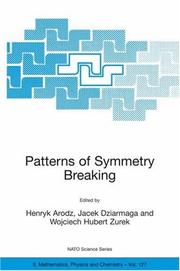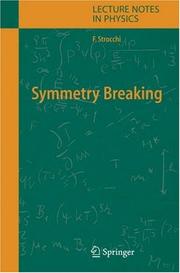| Listing 1 - 7 of 7 |
Sort by
|

ISBN: 9810226314 Year: 1996 Volume: vol. 16 Publisher: Singapore ; River Edge, NJ : World Scientific,
Abstract | Keywords | Export | Availability | Bookmark
 Loading...
Loading...Choose an application
- Reference Manager
- EndNote
- RefWorks (Direct export to RefWorks)
Book
Year: 1975 Volume: 47 Publisher: Reading, Mass. : W. A. Benjamin, Advanced Book Program,
Abstract | Keywords | Export | Availability | Bookmark
 Loading...
Loading...Choose an application
- Reference Manager
- EndNote
- RefWorks (Direct export to RefWorks)
Correlation (Statistics) --- Fluid dynamics --- Broken symmetry (Physics) --- Spin waves --- Corrélation (Statistique) --- Fluides, Dynamique des --- Symétrie brisée (Physique)
Book
ISBN: 2705613781 9782705613785 Year: 1976 Volume: 1378 Publisher: Paris: Hermann,
Abstract | Keywords | Export | Availability | Bookmark
 Loading...
Loading...Choose an application
- Reference Manager
- EndNote
- RefWorks (Direct export to RefWorks)
Book
ISBN: 9780198865254 9780198865247 9780192634535 Year: 2021 Publisher: Oxford : Oxford University Press,
Abstract | Keywords | Export | Availability | Bookmark
 Loading...
Loading...Choose an application
- Reference Manager
- EndNote
- RefWorks (Direct export to RefWorks)
Statistical mechanics is a core topic in modern physics. Innovative, fresh introduction to the broad range of topics of statistical mechanics today, by brilliant teacher and renowned researcher.
Statistical mechanics --- Entropy --- Phase transformations (Statistical physics) --- Broken symmetry (Physics) --- Mécanique statistique --- Entropie --- Transitions de phases --- Symétrie brisée (physique) --- Study and teaching (Higher) --- Étude et enseignement (supérieur) --- Mechanics --- Mechanics, Analytic --- Quantum statistics --- Statistical physics --- Thermodynamics --- Mécanique statistique --- Symétrie brisée (physique) --- Étude et enseignement (supérieur)


ISBN: 1402017448 1402017456 9400710291 Year: 2003 Volume: 127 Publisher: Dordrecht ; Boston ; London Brussels Kluwer Academic Publishers NATO Scientific Affairs Division
Abstract | Keywords | Export | Availability | Bookmark
 Loading...
Loading...Choose an application
- Reference Manager
- EndNote
- RefWorks (Direct export to RefWorks)
The conceptofspontaneous symmetry breaking plays a fundamental role in contemporary physics. It is essential for the description of degenerate ground states, massless modes, and topological defects. Examples are abundant in condensed matter physics, atomic and particle physics, as well as in astro physics and cosmology. In fact, spontaneous symmetry breaking can be re garded as a cornerstone ofa whole branch ofphysics which intersects the above mentioned traditionally distinct fields. In the year 2000 the European Science Foundation (ESF) started the Pro gramme "Cosmology in the Laboratory" (COSLAB), with the goal to search for and to develop analogies betweencondensed matterphysics, particle physics, and cosmology. Not surprisingly, spontaneous symmetry breaking is among the most useful notions in that endeavour. It has been decided that in the sec ond year of the Programme a School should be held in order to work out and deliver to a wide audience of students synthetic overviews of achievements and of current research topics of COSLAB. This idea has been supported by the Scientific and Environmental Affairs Division of NATO by including the School in the renowned series of its Advanced Study Institutes. The School, entitled" Patterns of Symmetry Breaking", was held in Cracow during 16-28 September 2002. It gathered 17 lecturers and about 60 students. The present volume contains notes ofmost of the lectures from that School. We hope that of the physics of spon it will convey to the reader the breadth and the beauty taneous symmetry breaking.
Broken symmetry (Physics) --- Phase transformations (Statistical physics) --- Symétrie brisée (Physique) --- Transformations de phase (Physique statistique) --- Symétrie brisée (Physique) --- Condensed matter. --- Mathematical physics. --- Statistical physics. --- Dynamical systems. --- Gravitation. --- Applied mathematics. --- Engineering mathematics. --- Condensed Matter Physics. --- Theoretical, Mathematical and Computational Physics. --- Complex Systems. --- Classical and Quantum Gravitation, Relativity Theory. --- Applications of Mathematics. --- Statistical Physics and Dynamical Systems. --- Engineering --- Engineering analysis --- Mathematical analysis --- Field theory (Physics) --- Matter --- Physics --- Antigravity --- Centrifugal force --- Relativity (Physics) --- Dynamical systems --- Kinetics --- Mathematics --- Mechanics, Analytic --- Force and energy --- Mechanics --- Statics --- Mathematical statistics --- Physical mathematics --- Condensed materials --- Condensed media --- Condensed phase --- Materials, Condensed --- Media, Condensed --- Phase, Condensed --- Liquids --- Solids --- Properties --- Statistical methods

ISBN: 354021318X 3540315365 Year: 2005 Volume: 643 Publisher: Berlin, Heidelberg : Springer Berlin Heidelberg : Imprint: Springer,
Abstract | Keywords | Export | Availability | Bookmark
 Loading...
Loading...Choose an application
- Reference Manager
- EndNote
- RefWorks (Direct export to RefWorks)
The intriguing mechanism of spontaneous symmetry breaking is a powerful innovative idea at the basis of most of the recent developments in theoretical physics, from statistical mechanics to many-body theory to elementary particles theory; for infinitely extended systems a symmetric Hamiltonian can account for non symmetric behaviours, giving rise to non symmetric realizations of a physical system. In the first part of this book, devoted to classical field theory, such a mechanism is explained in terms of the occurrence of disjoint sectors and their stability properties and of an improved version of the Noether theorem. For infinitely extended quantum systems, discussed in the second part, the mechanism is related to the occurrence of disjoint pure phases and characterized by a symmetry breaking order parameter, for which non perturbative criteria are discussed, following Wightman, and contrasted with the standard Goldstone perturbative strategy. The Goldstone theorem is discussed with a critical look at the hypotheses that emphasizes the crucial role of the dynamical delocalization induced by the interaction range. The Higgs mechanism in local gauges is explained in terms of the Gauss law constraint on the physical states. The mathematical details are kept to the minimum required to make the book accessible to students with basic knowledge of Hilbert space structures. Much of the material has not appeared in other textbooks.
Broken symmetry (Physics) --- Symétrie brisée (Physique) --- Physics. --- Quantum theory. --- Mathematical physics. --- Mathematical Methods in Physics. --- Quantum Physics. --- Mathematical and Computational Physics. --- Elementary Particles, Quantum Field Theory. --- Physics - General --- Atomic Physics --- Physics --- Physical Sciences & Mathematics --- Symétrie brisée (Physique) --- EPUB-LIV-FT SPRINGER-B --- Physical mathematics --- Quantum dynamics --- Quantum mechanics --- Quantum physics --- Natural philosophy --- Philosophy, Natural --- Symmetry breaking (Physics) --- Mathematics --- Quantum physics. --- Elementary particles (Physics). --- Quantum field theory. --- Theoretical, Mathematical and Computational Physics. --- Mechanics --- Thermodynamics --- Physical sciences --- Dynamics --- Relativistic quantum field theory --- Field theory (Physics) --- Quantum theory --- Relativity (Physics) --- Elementary particles (Physics) --- High energy physics --- Nuclear particles --- Nucleons --- Nuclear physics --- Particles (Nuclear physics)
Book
ISBN: 0201508826 Year: 1990 Publisher: Redwood City New York Madrid Addison-Wesley
Abstract | Keywords | Export | Availability | Bookmark
 Loading...
Loading...Choose an application
- Reference Manager
- EndNote
- RefWorks (Direct export to RefWorks)
Statistical physics --- Mathematical physics --- Fluid mechanics --- Analyse de corrélation --- Broken symmetry (Physics) --- Correlatie (Statistiek) --- Corrélation (Statistiques) --- Dynamique des fluides --- Gebroken symmetrie (Fysica) --- Ondes de spin --- Spin waves --- Spingolven --- Symetrie brisee (Physique) --- Vloeistofdynamica --- Symétrie brisée (Physique) --- Waves, Spin --- Low temperatures --- Symmetry breaking (Physics) --- Symétrie brisée (Physique) --- Correlation (Statistics) --- Fluid dynamics --- 519.233.5 --- 531.19 --- 532.5 --- 536.75 --- 538.93 --- 532.5 Liquid motion. Hydrodynamics --- Liquid motion. Hydrodynamics --- 531.19 Statistical mechanics --- Statistical mechanics --- 538.93 Transport processes (except in quantum liquids and solids) --- Transport processes (except in quantum liquids and solids) --- 519.233.5 Correlation analysis. Regression analysis --- Correlation analysis. Regression analysis --- Ferromagnetism --- Nuclear spin --- Dynamics --- Least squares --- Mathematical statistics --- Probabilities --- Regression analysis --- Statistics --- Instrumental variables (Statistics) --- Symmetry (Physics) --- 536.75 Entropy. Statistical thermodynamics. Irreversible processes --- Entropy. Statistical thermodynamics. Irreversible processes --- Graphic methods --- Corrélation (Statistique) --- Fluides, Dynamique des
| Listing 1 - 7 of 7 |
Sort by
|

 Search
Search Feedback
Feedback About UniCat
About UniCat  Help
Help News
News